One of the things I spend a lot of time explaining comes about when people want to go to broadband.
They've been working quite happily for a long time with a simple modem (typically a wire coming out of the back of the computer and going to the phone socket) and now they want to go broadband.
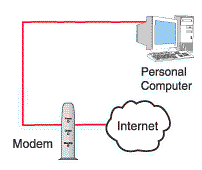
OK, let's do the easy bit first... you can have the equivalent setup for broadband... a modem connected to your computer (almost always via a USB port) which connects to the phone line. But then comes the question, "can I use it with my laptop downstairs?".
This opens a fresh can of worms, cos now it starts to get a bit more messy.
Let's see if a bit of basic understanding can help (and if ANY of this is not clear, please let me know so I can fix it!).
When you connect to the internet (dial up, broadband or whatever) your computer becomes just one computer attached to a vast network of computers (it's difficult to estimate how many but it will certainly be tens of millions and possibly hundreds, at any one time). This all works because your computer is given a unique number to identify it (you may have come across 'IP addresses' - think of them as international phone numbers).
Aside: Of course, one of the concepts of networks is that any machine can talk to any other machine and access any things that are on that machine! Scary or what? This is why it is important that you have a firewall running on your machine; it makes sure that strangers CANNOT get at your machine (phew!).
Right, so you can connect to the internet and make your computer part of this vast network... but what about your laptop?
Aside: For those who are ahead of the game, I'm not going to talk about sharing your internet connection with other users on your home network; that should be the subject of another posting (or not). If this bit has lost you, don't worry; you don't need to know!
Let's start by losing the modem that's connected to your computer; it's not much use in the scheme of things (at least for what we want); it's designed to connect just one computer to the internet.
I'm afraid it's time to get a few bits of jargon sorted:
- A modem is a device which allows a system to 'talk' to the internet; a bit like how you use a phone to talk to the telephone network.
- A switch (or, in 'olden' times, a hub) is a device which allows a number of machines to talk to each other on the same network.
- A router is a device which allows two different networks to talk to one another. It takes messages from one network and routes them to the correct place on a different network.
What we want is a load of computers in your home (we'll call this your local network) to connect to the internet.
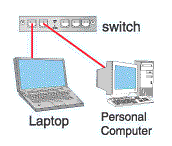
Well, a 'switch' allows several machines to exist on the same network so let's fasten all your computers together, using cables and a switch.
Of course, this just gives us a wired local network; it's not connected to the internet and in order to do that there needs to be a modem.
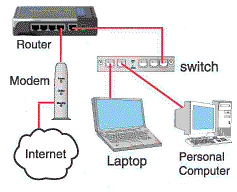
The problem now is that the internet and your local network are different networks and they can't talk to each other unless a router is added to the setup!
Fortunately thereis a simpler looking solution since a single box can do the work of the switch, the router and the modem. This is generally known as a broadband (or ADSL) modem router. 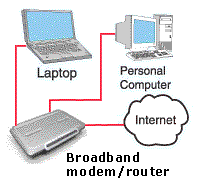
OK,what we've now got is a number of your computers able to talk to each other (maybe this is something you could make use of because you could backup all your valuable data (photographs and so forth) onto another machine), however, it's still all using wires and we want a wireless connection.
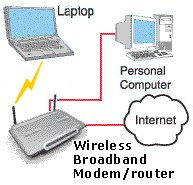
Fortunately we don't need yet another box in the connection, we just need to add an aerial or two to the router so it can work wirelessly. OK, you actually need a wireless modem router which would have one or more aerials (although they could be hidden inside).
What the wireless connection does is simply to allow a computer to connect using a wireless signal rather than a piece of wire; it's no more complicated than that!
So that's it. Your various computers can talk to the internet or, in a simple form, take away all those wired machines and just connect your laptop to the internet from the comfort of your sofa.
If any (or all) of this has been confusing (or helpful) please send a comment so it can, hopefully, be made better. If you're an expert and have noticed a few inaccuracies, please be tolerant and realise that this is trying to explain technical stuff in a non-technical way!

